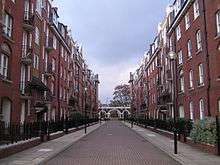Four Per Cent Industrial Dwellings Company
| Public | |
| Industry | Housing |
| Predecessor | Four Per Cent Industrial Dwellings Company; Industrial Dwellings Society (1885) Ltd. |
| Founder | Nathan Rothschild |
| Headquarters | London, London |
Area served | London Boroughs of Hackney, Tower Hamlets, Southwark, Redbridge and Barnet |
Key people | Evelyn de Rothschild (president), Samuel Montagu, Frederick Mocatta |
| Products | Model dwellings |
The Four Per Cent Industrial Dwellings Company was a philanthropic model dwellings company, formed in London in 1885, during the Victorian era.
In 1952, it was renamed the Industrial Dwellings Society (1885) Ltd. and is today known as IDS.[1] The IDS manages over 1,400 properties in the London Boroughs of Hackney, Tower Hamlets, Southwark, Redbridge, Hertsmere and Barnet. Its president is Sir Evelyn de Rothschild, a descendent of the banker Nathan Mayer Rothschild, who founded the Society.
History
The foundation of the company followed the United Synagogue's enquiry into "spiritual destitution" in 1884.[2]
The company was founded in 1885 by Rothschild and a board of other prominent, Jewish philanthropists including Frederick Mocatta and Samuel Montagu, to provide "the industrial classes with commodious and healthy Dwellings at a minimum rent".[3] The company was founded as a private capital concern, with capital of £50,000 in 5000 shares of £10 each:
It is estimated that if the rentals were based on a net return of 4 per cent excellent accommodation consisting of two rooms, a small scullery, and w.c. could be supplied at a weekly rental of five shillings per tenement; and it is considered that many investors will be found willing and even anxious to contribute their capital towards a scheme, which while yielding a moderate and safe return, will largely tend, not only to improve the dwellings of the poor, but also reduce the high rates now paid for the minimum of accommodation.[4]
Of this, Rothschild himself subscribed £10,000, and even paid for the site of the Company's first project (in Flower and Dean Street, Spitalfields) himself, months before the first meeting of the Company directors.[5]
These first buildings were to be known as Charlotte de Rothschild Buildings, after Lord Rothschild's mother,[5] and took up parts of Thrawl Street, Flower and Dean Street, and George Street, Spitalfields.[6]
The majority of the Four Per Cent Company's tenants were Jewish.[3] By 1905, it had built six large blocks (known as 'Rothschild houses'[2] comprising around 1,500 flats,[3] or 3,800 rooms.[7] "Each had two rooms, shared a toilet and kitchen with the adjacent flat, and opened to outdoor halls and stairways. In order to reimburse investors at the promised rate, the six storey buildings occupies no less than 50% of the ground space and tenants paid about 5s to 6s a week (25p to 30p). These grey stone houses were drab and draughty, but they were also solid and sanitary, and were probably better flats than those in other projects of the time."[8]
Present day
Today, IDS manages a large number of properties, predominantly in the East of London, but also in Southwark, Hertsmere and Barnet, including flats, houses, sheltered housing, accommodation for people with special needs, key worker housing and shared ownership properties. It still specialises in culturally specific housing[9] and acquired the Ajex Housing Association for Jewish ex-servicemen/women in 2006; IDS also work with the Otto Schiff housing association, Agudas Israel Housing Association and the Bangla Housing Association. IDS is chaired by Jonathan Davies and the Chief Executive is Paul Westbrook.
Buildings

- Charlotte de Rothschild Dwellings, Flower and Dean Street, Spitalfields (aka Rothschild Buildings) (1886)
- Nathaniel Dwellings, Flower and Dean Street, Spitalfields
- Mocatta House, Brady Street, Whitechapel (1890)
- Navarino Mansions, Dalston Lane, Hackney (1903-5)[10]
- Stepney Green Court, Stepney Green
Further reading
- White, J., (1980) Rothschild Buildings: life in an East End tenement block, 1887-1920
- Tarn, N.N. (1973) Five per cent philanthropy
See also
References
- ↑ IDS website
- 1 2 jewisheastend.com
- 1 2 3 20th Century London
- ↑ Jewish Chronicle, 13 March 1885
- 1 2 White, J. (1980) Rothschild Buildings: life in an East End tenement block, 1887-1920, p.21
- ↑ Jewish Chronicle, 10 December 1886
- ↑ Tarn, JN (1973) Five per cent philanthropy London:CUP, p.104
- ↑ Gartner, LP, The Jewish Immigrant 1870-1914
- ↑ IDS website
- ↑ Geograph